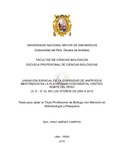Por favor, use este identificador para citar o enlazar este ítem:
https://hdl.handle.net/20.500.12958/3169Registro completo de metadatos
| Campo DC | Valor | Lengua/Idioma |
|---|---|---|
| dc.contributor.advisor | Romero chumpitaz, Leonardo | - |
| dc.contributor.author | Jiménez Campeán, Analí | - |
| dc.date.accessioned | 2018-02-06T17:33:02Z | - |
| dc.date.available | 2018-02-06T17:33:02Z | - |
| dc.date.issued | 2018 | - |
| dc.identifier.uri | https://hdl.handle.net/20.500.12958/3169 | - |
| dc.description | Tesis (Bióloga con mención en Hidrobiología y Pesquería).- Universidad Nacional Mayor de San Marcos. Facultad de Ciencias Biológicas. EAP. Ciencias Biológicas. | es_ES |
| dc.description.abstract | Los anfípodos bentónicos constituyen un importante recurso nutricional para los niveles tróficos superiores y representan un buen indicador del estado de los ecosistemas marinos. En este estudio se describe la distribución espacial de anfípodos bentónicos sublitorales frente a Perú (3°24’ - 9°00’S y 79°30’ - 81°30’W) en base al análisis de 181 muestras de fondo blando colectadas con una draga tipo Van Veen de 0.1 m-2 de cobertura, a profundidades que oscilaron entre 22 y 380 m durante la estación de otoño, entre los años 2004 a 2010. El estudio determinó un total de 43 taxa en la Plataforma Continental centronorte peruana, contenidas en los subórdenes Amphilochidea y Senticaudata. Las familias con mayor riqueza fueron: Ampeliscidae, 11 taxa, Oedicerotidae y Photidae, 4 taxa cada una; Liljeborgiidae, 3, Phoxocephalidae, Synopiidae, Megaluropidae, y Lysianassidae, con 2 taxa cada una. Heterophoxus oculatus y Ampelisca mexicana fueron las especies más frecuentes, entre 50 y 200 m de profundidad, al norte de los 6° S. La riqueza de especies exhibió correlaciones positivas con altos niveles de oxigenación y baja concentración de clorofila-a en el sedimento superficial (p<0.01). No obstante, entre los 6° y 9° S se observó la dominancia de Ampelisca araucana asociada a condiciones moderadas de hipoxia (OD< 0.5 mL/L) y altos contenidos de materia orgánica fresca (Cl-a) en el sedimento superficial. Asimismo, estos factores determinaron la agrupación de dos asociaciones de especies con microhábitats incluidos dentro de la Provincia Panameña, incluyendo la zona de transición frente a Paita, y otra en la Provincia Peruana. | es_ES |
| dc.description.abstract | ABSTRACT: Benthic marine amphipods are an important nutritional resource for higher trophic levels and is a good indicator of the states of marine ecosystems. This study was made in the north central Peruvian continental shelf (3° 24’ – 9° 00’ S and 79° 30’ – 81° 30’ W). It described the spatial distribution of sublitoral benthic amphipod, using 181 soft-bottom samples collected with a Van Veen grab of 0.1m2, at depths ranging from 22 to 380 m during the autumn season, between 2004 and 2010. In this period, 43 species were identified belonging to Amphilochidea and Senticaudata suborders. The highest richness was in Ampeliscidae family with 11 species; Photidae and Oedicerotidae with 04 species each; Liljeborgiidae, with 03; Phoxocephalidae, Synopiidae, Megaluropidae and Lysianassidae, with 02 species each. Heterophoxus oculatus and Ampelisca mexicana were the most frequent between the 50 to 200 m depth at the north of 6° S. The richness of species showed positive correlations with high levels of oxygenation and low concentration of chlorophyll – a in the surface sediment (p < 0.01). However, between 6° and 9° S, Ampelisca araucana was dominant associated with moderate hypoxia conditions (OD < 0.5 mL/L) and high content of fresh organic matter (Chl-a) in the sediment. Therefore, these factors determined the distribution of the two associations of species grouped in the Panamic Province (including the Paita Transition Zone), and Peruvian Province. | - |
| dc.language.iso | spa | es_ES |
| dc.publisher | Lima | es_ES |
| dc.rights | info:eu-repo/semantics/openAccess | es_ES |
| dc.rights.uri | https://creativecommons.org/licenses/by/4.0/ | - |
| dc.source | Instituto del Mar del Perú - IMARPE | es_ES |
| dc.source.uri | Repositorio Digital IMARPE | es_ES |
| dc.subject | Anfípodos | es_ES |
| dc.subject | Ecosistema Marino | es_ES |
| dc.subject | Clorofila | es_ES |
| dc.subject | Bentos Marinos | es_ES |
| dc.title | Variación espacial de la diversidad de anfípodos bentónicos en la plataforma continental centro-norte del Perú (3.4° - 9° S), en los otoños de 2004 a 2010 | es_ES |
| dc.type | info:eu-repo/semantics/bachelorThesis | es_ES |
| Aparece en las colecciones: | Tesis de Grado | |
Ficheros en este ítem:
| Fichero | Descripción | Tamaño | Formato | |
|---|---|---|---|---|
| Jimenez Campean.pdf | 2,61 MB | Adobe PDF |  Visualizar/Abrir |
Este ítem está sujeto a una licencia Creative Commons Licencia Creative Commons

